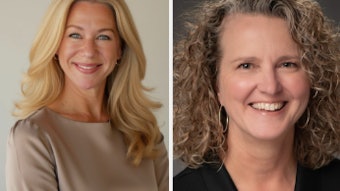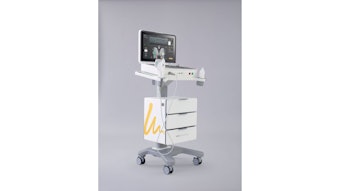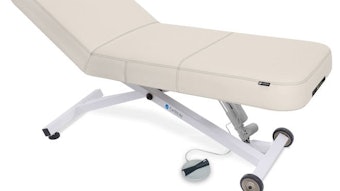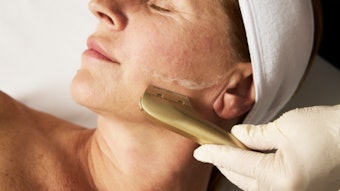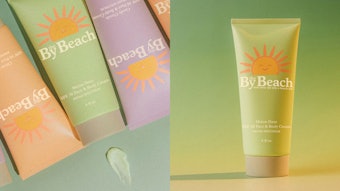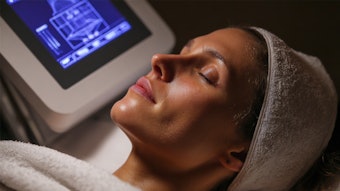Ask a group of people which superpower each would choose and the answers would quite likely include the ability to fly, invisibility, the power to freeze time and even time travel. If Louanne Roark could assume any superpower—one already known or one as yet unleashed upon the world—she would choose the one that would put her out of a job. Such power would be welcome if it meant she could find the cure for cancer and eliminate the need for Look Good ... Feel Better (LGFB), the program she oversees as executive director of the Personal Care Products Council (PCPC) Foundation.
LGFB is a free, nonmedical, brand-neutral, national public service program started to help women cope with the appearance-related side effects of cancer treatment through workshops in which beauty professionals offer tips about skin care, makeup techniques and guidance for coping with hair loss. The program has served some 600,000 people in the U.S. since it began in 1989. As Foundation executive director, Roark is responsible for all aspects of operations, as well as the LGFB program, from establishing strategic direction and priorities to program operations and implementation. She oversees funding and development and nurtures the Foundation’s long collaboration with the American Cancer Society (ACS) and the National Cosmetology Association (NCA).
Roark has served as executive director of the Foundation for about three years, but she has been involved with LGFB almost since its inception. She worked on the program from 1990–2000, holding the positions of LGFB program manager, Foundation associate director and Foundation director. Carolyn Deaver, whose name was nearly synonymous with LGFB when she was its executive director, worked with Roark and remembers her as a good listener, an excellent problem solver and, “most importantly, committed to doing the best possible job to help people facing cancer, as well as representing the cosmetic industry and the important role
[it plays] in LGFB.” Deaver was instrumen-tal in bringing Roark back to the program, and Roark considers Deaver a mentor.
“As I approached my retirement, I knew that Louanne would be just the person to pick up the program and continue to make it grow,” says Deaver. “I understood her reasons for leaving the foundation after 10 years for a position with a public relations agency, but I still felt that she had a soft spot in her heart for LGFB.”
PCP Council President Pam Bailey echoes Deaver’s support. “Louanne has been an enthusiastic advocate in her commitment to improving the lives of women undergoing cancer treatment. She is steadfast in honoring and building upon the foundation laid by Carolyn Deaver, LGFB’s longest serving executive director, by continually looking for opportunities to increase awareness of the program. Louanne’s leadership, passion, and empathy have served the Foundation well, and I am proud to have her on our team.” Much of what makes Roark so right for the job is rooted in her Florida childhood.
A Foundation for Success
Roark was raised in St. Petersburg, Florida, by parents who were originally from Kentucky; it was an upbringing steeped in Southern traditions. She describes her family, both the nuclear and the extended, as nurturing and close-knit. “They truly believed in the ‘It takes a village’ philosophy of family and community, and that is very much a part of who I am and how I was raised,” says Roark.
Her lifelong interest in health care and the biological sciences, grew through observing her mother, a registered nurse now retired, who Roark says embodies the concept of giving back to and caring for others. She describes her father, a retired electrical engineer, as a generous man. “I can’t even count how many neighborhood kids and protégés he tutored through high school or college math and engineering courses, myself included,” says Roark.
Her early career was in sales, marketing and public relations positions in the hospitality business. In the years between her two stints at PCPC, 2000–2005, she was a senior vice president at Ketchum Public Relations, running its women’s health business out of Washington, D.C.
Back at the Foundation, Roark finds much to like about her job. Chiefly, she enjoys working for an industry with what she calls “an amazing philanthropic spirit; an industry that truly believes that [it has] a responsibility to give back.” She considers it a privilege to work for an organization offering a valuable public service program making a real difference in the lives of people facing life-threatening illness.
“I am incredibly lucky to be in a role where I can match my professional skills with my passion,” says Roark. “Not many people have that opportunity in their professional lives, and I am thankful every day that I do.”
In days filled with meetings and conversations with collaborators and corporate supporters, she makes a point of spending time with the folks that ultimately matter in all this by attending several LGFB workshops every year. “It always refreshes me and clarifies my focus when I see and experience the program from a participant’s perspective,” says Roark.
Of course, serving those participants takes both time and money, and Roark spends as much as 15% of her time on fundraising efforts for LGFB. She is candid in expresing the one thing that would make her job easier: a significant financial endowment. Such an endowment would enable the Foundation to dramatically increase the number of people it serves, and support research about the effects of positive self-esteem and body image on the quality of life of cancer survivors.
DreamBall, the main LGFB fundraising event, also demands her time. Roark works closely with the ACS and the DreamBall executive committee, of which both Roark and PCPC executive director Pam Bailey are members, on DreamBall planning and execution, which starts early every year.
A Dream of a Fundraiser
DreamBall was founded in the 1980s to bring together the cosmetic industry and the ACS in raising money to support cancer-related projects. Over the years, the event has grown from raising a modest amount of funds before the development and addition of LGFB, to an event now grossing between $2.2 and $2.5 million annually. It is one of the single largest fundraising events the ACS is involved with nationwide, having raised some $31 million since 1989. The funds from the DreamBall are split evenly between the Foundation and the ACS.
In 1999, LGFB’s tenth anniverary year, the DreamGirl role was formed as a way to deliver a testimonial from a program participant to help the industry truly understand the value of the program and why its support is so vital. “Our first DreamGirl was a wonderful woman named Carol Udycz who was a Cleveland nurse and breast cancer patient,” says Roark. “She was a perfect spokesperson, because she knew the program both from a health care provider perspective—[since] she had referred many of her patients to LGFB—as well as from a personal perspective as a cancer patient and participant. She was also one of the warmest, most caring and upbeat individuals I have had the pleasure of knowing.” The DreamGirls are an important part of the team making LGFB happen.
It Takes a Team
Roark’s in-house team consists of four full-time program staff, a full-time contractor in Atlanta who oversees warehouse operations, and about 20 senior citizens who are part-time employees supporting the warehouse operation and product assembly process, who Roark calls “incredibly dedicated.” She proudly states: “This team is so dedicated to LGFB, and they all share the same passion for the program and the value it brings to patients.” Among the Washington D.C. based staff, the LGFB program director, Lisa Burris, spent many years managing patient service and support programs for the American Cancer Society’s Mid-Atlantic division, says Roark. Two of her staff have been with the association and/or the Foundation for 20 years, with the majority of her time spent working on LGFB. A group of external supporters from many professional disciplines also share a passion for the value of LGFB, giving generously of their time and talents. This “brain trust,” as Roark calls them, includes the Foundation’s board of directors and industry supporters who provide financial support, in-kind donations, support, insight and guidance. “We have enjoyed their unwavering support since before the LGFB program was launched nearly 19 years ago,” says Roark. “When I talk about the philanthropic spirit of the cosmetic and personal care products industry, this is what I mean—a willingness to put time, money and their collective muscle consistently behind a cause they believe in.”
According to Bailey, LGFB is an important part of the Council’s work on behalf of its members and consumers who use its products. “Cosmetic companies have always been dedicated to improving the quality of life for their consumers. LGFB demonstrates the collective philanthropic values and corporate responsibility our members take very seriously. It’s an extension of our mission—allowing us to use our resources and partnerships so every woman living with cancer can benefit from our members’ philanthropic commitment.”
The 50 or so companies that donate between 700,000 and one million pieces of product each year, with a value of about $10 million, are vital to LGFB success. Deaver says the cosmetic and personal care industry has always been very supportive and proud of the LGFB program, and she calls its donations of funding and product truly remarkable. “As the program has grown and the needs increased, the industry has stepped up to the challenge of providing increasing funding and product donations,” says Deaver. Roark, too, is appreciative. “I want the personal care products companies and professionals reading GCI magazine to know how much their support means to LGFB, both on a corporate and a personal level. We appreciate their contributions so very much,” says Roark. “I want to encourage them to get involved with the program if they are not already participating.”
Program support doesn’t end there. It also comes from collaborating organizations ACS and NCA, as well as from experts in the psycho-social needs of cancer patients, among them Julia Rowland, PhD, head of the office of cancer survivorship at the National Cancer Institute. The Foundation’s relationship with the ACS started during the late pilot phase of the LGFB program in 1988. “As the premier oncology health organization working with the public, and with more than 3,000 local, staffed offices, the ACS was an ideal partner to help deliver LGFB to cancer patients,” says Roark. “We had the added benefit of the first-ever female chairman of ACS—Kay Horsch—at the helm of the ACS board during this time in the late 80s, and she embraced the concept and opportunity to help female cancer patients in a new and significant way.” Today, the ACS administers the LGFB program at the local level. NCA’s contribution is its membership, comprised of about 20,000 salon-based beauty professionals, including hairstylists, estheticians, makeup artists and nail technicians, who serve as LGFB volunteers. “I find it quite remarkable that three organizations with such diverse missions have collaborated for 19 years on a common program,” she says. “It is a strong testament to our shared belief in the value of the program and our shared desire to help cancer patients overcome obstacles during their treatment.
“And, I can’t say enough about the 10,000 volunteers who support the program or the countless health care professionals who refer patients to LGFB across the country,” says Roark. “Each and every one of these supporters makes a positive difference in our ability to reach and serve women, men and teens with cancer. We couldn’t do it without them.”
Most of the program volunteers are beauty professionals who Roark says are natural educators—a trait that comes through effortlessly in the LGFB programs. “Participants immediately feel it and respond positively,” she says. “Every time I attend a LGFB workshop, I always leave feeling grateful for their contributions and hoping that I might be able to emulate even a small percentage of their generosity and kindness. Day after day, they go out of their way to help others—using their own time and sometimes even their own resources to give a part of themselves to make someone else’s day brighter and more hopeful.”
Of the LGFB participants, Roark says she admires “their resilience, courage and humor in the face of an often frightening and overwhelming illness. Their embrace of life and appreciation of the things that really matter offers an example to each and every one of us to appreciate what we have and those who love and care for us.”
Continue reading this article. You will be redirected to GCI magazine's Web site.
LGFB is a free, nonmedical, brand-neutral, national public service program started to help women cope with the appearance-related side effects of cancer treatment through workshops in which beauty professionals offer tips about skin care, makeup techniques and guidance for coping with hair loss. The program has served some 600,000 people in the U.S. since it began in 1989. As Foundation executive director, Roark is responsible for all aspects of operations, as well as the LGFB program, from establishing strategic direction and priorities to program operations and implementation. She oversees funding and development and nurtures the Foundation’s long collaboration with the American Cancer Society (ACS) and the National Cosmetology Association (NCA).
Roark has served as executive director of the Foundation for about three years, but she has been involved with LGFB almost since its inception. She worked on the program from 1990–2000, holding the positions of LGFB program manager, Foundation associate director and Foundation director. Carolyn Deaver, whose name was nearly synonymous with LGFB when she was its executive director, worked with Roark and remembers her as a good listener, an excellent problem solver and, “most importantly, committed to doing the best possible job to help people facing cancer, as well as representing the cosmetic industry and the important role
[it plays] in LGFB.” Deaver was instrumen-tal in bringing Roark back to the program, and Roark considers Deaver a mentor.
“As I approached my retirement, I knew that Louanne would be just the person to pick up the program and continue to make it grow,” says Deaver. “I understood her reasons for leaving the foundation after 10 years for a position with a public relations agency, but I still felt that she had a soft spot in her heart for LGFB.”
PCP Council President Pam Bailey echoes Deaver’s support. “Louanne has been an enthusiastic advocate in her commitment to improving the lives of women undergoing cancer treatment. She is steadfast in honoring and building upon the foundation laid by Carolyn Deaver, LGFB’s longest serving executive director, by continually looking for opportunities to increase awareness of the program. Louanne’s leadership, passion, and empathy have served the Foundation well, and I am proud to have her on our team.” Much of what makes Roark so right for the job is rooted in her Florida childhood.
A Foundation for Success
Roark was raised in St. Petersburg, Florida, by parents who were originally from Kentucky; it was an upbringing steeped in Southern traditions. She describes her family, both the nuclear and the extended, as nurturing and close-knit. “They truly believed in the ‘It takes a village’ philosophy of family and community, and that is very much a part of who I am and how I was raised,” says Roark.
Her lifelong interest in health care and the biological sciences, grew through observing her mother, a registered nurse now retired, who Roark says embodies the concept of giving back to and caring for others. She describes her father, a retired electrical engineer, as a generous man. “I can’t even count how many neighborhood kids and protégés he tutored through high school or college math and engineering courses, myself included,” says Roark.
Her early career was in sales, marketing and public relations positions in the hospitality business. In the years between her two stints at PCPC, 2000–2005, she was a senior vice president at Ketchum Public Relations, running its women’s health business out of Washington, D.C.
Back at the Foundation, Roark finds much to like about her job. Chiefly, she enjoys working for an industry with what she calls “an amazing philanthropic spirit; an industry that truly believes that [it has] a responsibility to give back.” She considers it a privilege to work for an organization offering a valuable public service program making a real difference in the lives of people facing life-threatening illness.
“I am incredibly lucky to be in a role where I can match my professional skills with my passion,” says Roark. “Not many people have that opportunity in their professional lives, and I am thankful every day that I do.”
In days filled with meetings and conversations with collaborators and corporate supporters, she makes a point of spending time with the folks that ultimately matter in all this by attending several LGFB workshops every year. “It always refreshes me and clarifies my focus when I see and experience the program from a participant’s perspective,” says Roark.
Of course, serving those participants takes both time and money, and Roark spends as much as 15% of her time on fundraising efforts for LGFB. She is candid in expresing the one thing that would make her job easier: a significant financial endowment. Such an endowment would enable the Foundation to dramatically increase the number of people it serves, and support research about the effects of positive self-esteem and body image on the quality of life of cancer survivors.
DreamBall, the main LGFB fundraising event, also demands her time. Roark works closely with the ACS and the DreamBall executive committee, of which both Roark and PCPC executive director Pam Bailey are members, on DreamBall planning and execution, which starts early every year.
A Dream of a Fundraiser
DreamBall was founded in the 1980s to bring together the cosmetic industry and the ACS in raising money to support cancer-related projects. Over the years, the event has grown from raising a modest amount of funds before the development and addition of LGFB, to an event now grossing between $2.2 and $2.5 million annually. It is one of the single largest fundraising events the ACS is involved with nationwide, having raised some $31 million since 1989. The funds from the DreamBall are split evenly between the Foundation and the ACS.
In 1999, LGFB’s tenth anniverary year, the DreamGirl role was formed as a way to deliver a testimonial from a program participant to help the industry truly understand the value of the program and why its support is so vital. “Our first DreamGirl was a wonderful woman named Carol Udycz who was a Cleveland nurse and breast cancer patient,” says Roark. “She was a perfect spokesperson, because she knew the program both from a health care provider perspective—[since] she had referred many of her patients to LGFB—as well as from a personal perspective as a cancer patient and participant. She was also one of the warmest, most caring and upbeat individuals I have had the pleasure of knowing.” The DreamGirls are an important part of the team making LGFB happen.
It Takes a Team
Roark’s in-house team consists of four full-time program staff, a full-time contractor in Atlanta who oversees warehouse operations, and about 20 senior citizens who are part-time employees supporting the warehouse operation and product assembly process, who Roark calls “incredibly dedicated.” She proudly states: “This team is so dedicated to LGFB, and they all share the same passion for the program and the value it brings to patients.” Among the Washington D.C. based staff, the LGFB program director, Lisa Burris, spent many years managing patient service and support programs for the American Cancer Society’s Mid-Atlantic division, says Roark. Two of her staff have been with the association and/or the Foundation for 20 years, with the majority of her time spent working on LGFB. A group of external supporters from many professional disciplines also share a passion for the value of LGFB, giving generously of their time and talents. This “brain trust,” as Roark calls them, includes the Foundation’s board of directors and industry supporters who provide financial support, in-kind donations, support, insight and guidance. “We have enjoyed their unwavering support since before the LGFB program was launched nearly 19 years ago,” says Roark. “When I talk about the philanthropic spirit of the cosmetic and personal care products industry, this is what I mean—a willingness to put time, money and their collective muscle consistently behind a cause they believe in.”
According to Bailey, LGFB is an important part of the Council’s work on behalf of its members and consumers who use its products. “Cosmetic companies have always been dedicated to improving the quality of life for their consumers. LGFB demonstrates the collective philanthropic values and corporate responsibility our members take very seriously. It’s an extension of our mission—allowing us to use our resources and partnerships so every woman living with cancer can benefit from our members’ philanthropic commitment.”
The 50 or so companies that donate between 700,000 and one million pieces of product each year, with a value of about $10 million, are vital to LGFB success. Deaver says the cosmetic and personal care industry has always been very supportive and proud of the LGFB program, and she calls its donations of funding and product truly remarkable. “As the program has grown and the needs increased, the industry has stepped up to the challenge of providing increasing funding and product donations,” says Deaver. Roark, too, is appreciative. “I want the personal care products companies and professionals reading GCI magazine to know how much their support means to LGFB, both on a corporate and a personal level. We appreciate their contributions so very much,” says Roark. “I want to encourage them to get involved with the program if they are not already participating.”
Program support doesn’t end there. It also comes from collaborating organizations ACS and NCA, as well as from experts in the psycho-social needs of cancer patients, among them Julia Rowland, PhD, head of the office of cancer survivorship at the National Cancer Institute. The Foundation’s relationship with the ACS started during the late pilot phase of the LGFB program in 1988. “As the premier oncology health organization working with the public, and with more than 3,000 local, staffed offices, the ACS was an ideal partner to help deliver LGFB to cancer patients,” says Roark. “We had the added benefit of the first-ever female chairman of ACS—Kay Horsch—at the helm of the ACS board during this time in the late 80s, and she embraced the concept and opportunity to help female cancer patients in a new and significant way.” Today, the ACS administers the LGFB program at the local level. NCA’s contribution is its membership, comprised of about 20,000 salon-based beauty professionals, including hairstylists, estheticians, makeup artists and nail technicians, who serve as LGFB volunteers. “I find it quite remarkable that three organizations with such diverse missions have collaborated for 19 years on a common program,” she says. “It is a strong testament to our shared belief in the value of the program and our shared desire to help cancer patients overcome obstacles during their treatment.
“And, I can’t say enough about the 10,000 volunteers who support the program or the countless health care professionals who refer patients to LGFB across the country,” says Roark. “Each and every one of these supporters makes a positive difference in our ability to reach and serve women, men and teens with cancer. We couldn’t do it without them.”
Most of the program volunteers are beauty professionals who Roark says are natural educators—a trait that comes through effortlessly in the LGFB programs. “Participants immediately feel it and respond positively,” she says. “Every time I attend a LGFB workshop, I always leave feeling grateful for their contributions and hoping that I might be able to emulate even a small percentage of their generosity and kindness. Day after day, they go out of their way to help others—using their own time and sometimes even their own resources to give a part of themselves to make someone else’s day brighter and more hopeful.”
Of the LGFB participants, Roark says she admires “their resilience, courage and humor in the face of an often frightening and overwhelming illness. Their embrace of life and appreciation of the things that really matter offers an example to each and every one of us to appreciate what we have and those who love and care for us.”
Continue reading this article. You will be redirected to GCI magazine's Web site.




